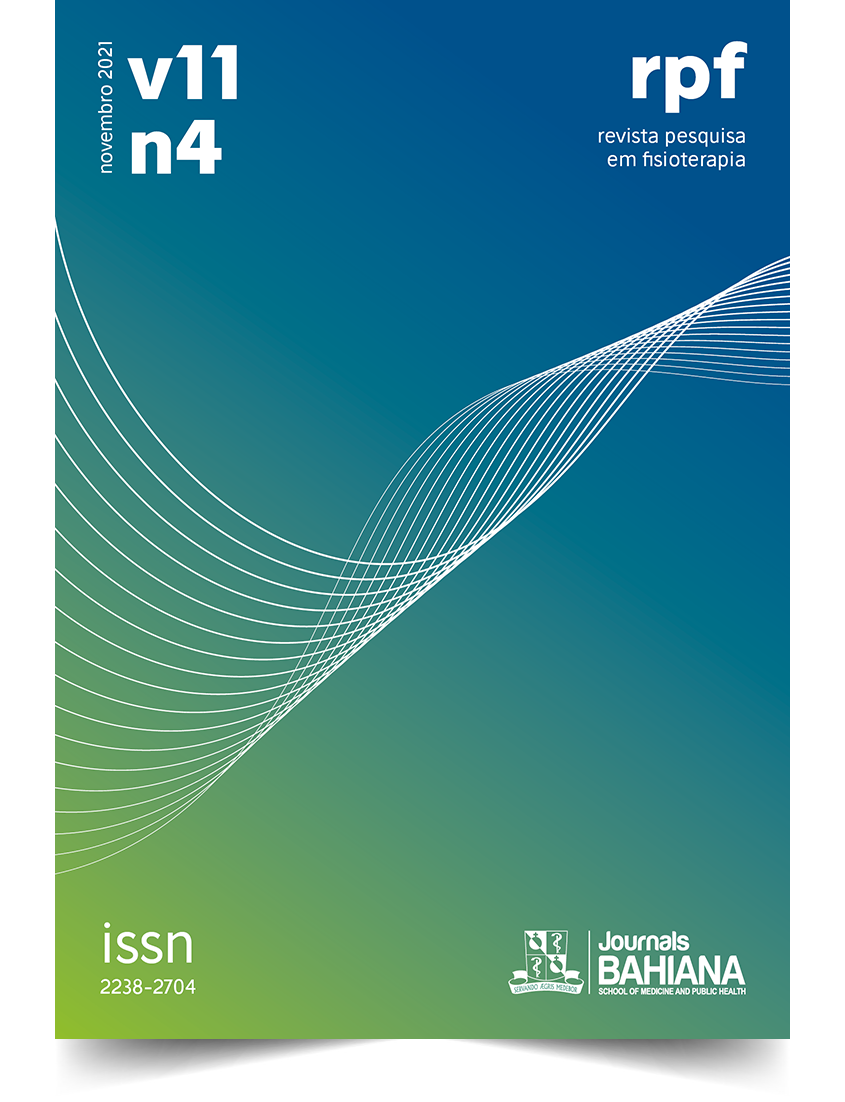Estimativa da taxa de pico de fluxo expiratório em jovens indianos
DOI:
https://doi.org/10.17267/2238-2704rpf.v11i4.3874Palavras-chave:
Pico de fluxo expiratório. , Adulto indiano, Equação de predição., Asma.Resumo
INTRODUÇÃO: O pico de fluxo expiratório (PFE) é comumente usado para monitorar a progressão de doenças respiratórias, pois fornece boas informações sobre o estado das vias aéreas. Uma boa quantidade de pesquisas está sendo feita em todo o mundo para estabelecer uma equação de previsão local. A força-tarefa conjunta da Sociedade Torácica Americana e da Sociedade Respiratória Europeia promoveu pesquisas a esse respeito. Índia, os dados derivados da população caucasiana ainda são usados ??para o PFE. OBJETIVO: Estudar a relação dos parâmetros do PFE e os dados antropométricos como idade, altura, peso, índice de massa corporal (IMC), área de superfície corporal (ASC) e estabelecer uma equação de regressão para jovens adultos indianos. MÉTODOS: PFE foi feito em 15-25 anos com 1000 indivíduos da região metropolitana de Mumbai. O coeficiente de correlação de Pearson foi usado para entender a relação dos parâmetros antropométricos e PFE. A análise de regressão multivariada foi feita para estabelecer uma equação de predição. (Alfa 5%) RESULTADOS: Idade e todos os parâmetros antropométricos foram correlacionados com PFE. O pico de fluxo expiratório médio da população masculina foi de 515 ml / seg, enquanto o feminino foi de 399 ml / seg. Para o PFE, a maior correlação foi observada com a ASC seguida de altura, peso e idade, enquanto o IMC apresentou o menor coeficiente de correlação. PEFR teve a melhor significância com a idade, BSA, altura e IMC. Teve menos significado com o peso. No sexo feminino, o PEFR teve a melhor significância com altura, peso, IMC e idade. CONCLUSÃO: Existem diferenças de gênero no PEFR. Portanto, equações específicas de gênero são necessárias para a estimativa do PEFR.
Downloads
Referências
Singh V, Sharma BB. Respiratory disease burden in India: Indian chest society SWORD survey. Lung India. 2018;35(6):459-60. https://dx.doi.org/10.4103%2Flungindia.lungindia_399_18
World Health Organization. Global surveillance, Prevention and control of chronic Respiratory diseases: A Comprehensive Approach [Internet]. Geneva: WHO; 2007. Available from: https://www.who.int/gard/publications/GARD_Manual/en/
Akinbami L. Asthma Prevalence, health care use and mortality report: Atlanta, united states 2003-05 [Internet]. National center for health statistics; 2006. Available from: https://www.cdc.gov/nchs/data/hestat/asthma03-05/asthma03-05.htm
Loftus PA, Wise SK. Epidemiology of Asthma. Curr Opin Otolaryngol Head Neck Surg. 2016;24(3):245-9. https://doi.org/10.1097/moo.0000000000000262
Global Asthma Network. The Global Asthma Report 2018 [Internet]. Auckland: Global Asthma Network; 2018. Available from: http://globalasthmareport.org/
Milleret MR. Peak expiratory flow meter scale changes: implications for patients and health professionals. Airways J [Internet]. 2004;2(2):80-2. Available from: https://health.utah.edu/sites/g/files/zrelqx131/files/media/documents/2020/Peak-expiratory-flow-meter-scale-changes.pdf
Nunn AJ, Gregg I. New regression equations for predicting peak expiratory flow in adults. BMJ. 1989;22:298(6680):1068–70. https://dx.doi.org/10.1136%2Fbmj.298.6680.1068
Kjellberg S, Houltz BK, Zetterström O, Robinson PD, Gustafsson PM. Clinical characteristics of adult asthma associated with small airway dysfunction. Respir Med. 2016;117:92-102. https://doi.org/10.1016/j.rmed.2016.05.028
Van Sickle D, Magzamen S, Mullahy J. Understanding socioeconomic and racial differences in adult lung function. Am J Respir Crit Care Med. 2011;184(5):521-7. https://doi.org/10.1164/rccm.201012-2095oc
Chhabra SK. Interpretation of Spirometry: Selection of Predicted Values and Defining Abnormality. Indian J Chest Dis Allied Sci. 2015;57(2):91-105. Cited: PMID: 26591969.
Stocks J, Coates A, Bush A. Lung function in infants and young children with chronic lung disease of infancy: the next steps? Pediatr Pulmonol. 2007;42(1):3-9. https://doi.org/10.1002/ppul.20520
Stanojevic S, Wade A, Cole TJ, Lum S, Custovic A, Silverman M, et al. Spirometry centile charts for young Caucasian children The Asthma UK Collaborative Initiative. Am J Respir Crit Care Med. 2009;180(6):547–52. https://doi.org/10.1164/rccm.200903-0323oc
Van Ganse WL, Billet L, Ferris B. Medical criteria for the selection of normal subjects. In: Arcangeli P, Cotes JE, Cournand A, Denolin H, Maria GD, Sadoul P, et al., editors. Introduction to the definition of normal values for respiratory function in man. Alghero, Italy: Panminerva Medica; 1969. p. 15-27
Leocádio RRV, Segundo AKR, Louzada CF. A Sensor for Spirometric Feedback in Ventilation Maneuvers during Cardiopulmonary Resuscitation Training. Sensors (Basel). 2019;19(23):5095. https://doi.org/10.3390/s19235095
Kale S, Deshpande M, Chaudhari S. Prediction model for peak expiratory flow rate in rural Indian girls. Int J Pharm Biomed Sci. 2021;12(2):68-72. http://dx.doi.org/10.22376/ijpbs.2021.12.2.p68-72
Aggarwal AN, Gupta D, Behera D, Jindal SK. Applicability of commonly used Caucasian prediction equations for spirometry interpretation in India. Indian J Med Res. 2005;122(2):153-64. Cited: PMID: 16177474.
Mittal S, Gupta S, Kumar A, Singh KD. Regression equations for peak expiratory flow in healthy children aged 7 to 14 years from Punjab, India. Lung India. 2013;30(3):183-6. https://doi.org/10.4103/0970-2113.116245
Kamat SR, Sarma BS, Raju VR, Venkataraman C, Balkrishna M, Bhavsar RC, et al. Indian norms for pulmonary function: observed values prediction equations and intercorrelations. J Assoc Physicians India. 1977;25(8):531-40. Cited: PMID: 614379.
Gupta CK, Mathur N. Statistical models relating peak expiratory flow rate of age, height, weight and sex. J. Epidemiology Community Health [Internet]. 1982;36(1):64-7. Available from: http://www.jstor.org/stable/25566300
Rastogi SK, Mathur N, Clerk SH. Ventilatory norms in healthy industrial male workers. Indian J Chest Dis Allied Sci. 1983;25(3):186-95. Cited: PMID: 6678227.
Dikshit MB, Raje S, Agrawal MJ. Lung functions with spirometry: an Indian perspective--I. Peak expiratory flow rates. Indian J Physiol Pharmacol. 2005;49(1):8-18. Cited: PMID: 15881854.
Vijayan VK, Reetha AM, Kuppurao KV, Venkatesan P, Thilakavathy S. Pulmonary function in normal south Indian children aged 7 to 19 years. Indian J Chest Dis Allied Sci. 2000;42(3):147-56. Cited: PMID: 11089318.
Bhardwaj P, Dwivedi VK. Peak Expiratory Flow Rate in Smoker and Non-Smoker Petrol Pump Workers in Haldwani. JMSCR. 2018;6(3):967-70. https://dx.doi.org/10.18535/jmscr/v6i3.161
Krishna KV, Kumar SA, Shivaprasad V, Desai RD. Peak expiratory flow rate and its correlation with weight in normal School children. Int J of Innovation and Scientific Research [Internet]. 2014;12(2):385-89. Available from: http://www.ijisr.issr-journals.org/abstract.php?article=IJISR-14-263-02
Canavese F, Dimeglio A, Bonnel F, Corradin M, Pereira B, Marcoul A, et al. Thoracic cage volume and dimension assessment by optoelectronic molding in normal children and adolescents during growth. Surg Radiol Anat. 2019;41(3):287-96. https://doi.org/10.1007/s00276-018-2164-4
Downloads
Publicado
Edição
Seção
Licença
Copyright (c) 2021 Sudeep Hiralal Kale

Este trabalho está licenciado sob uma licença Creative Commons Attribution 4.0 International License.
Esta obra está licenciada com uma Licença Creative Commons Atribuição 4.0 Internacional.



